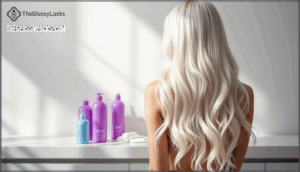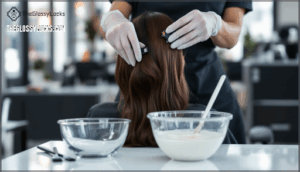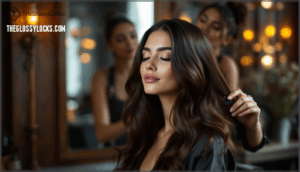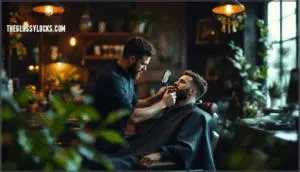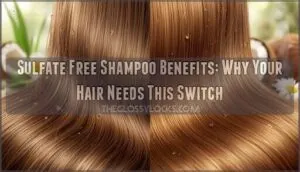This site is supported by our readers. We may earn a commission, at no cost to you, if you purchase through links.

They’re fixable, often without another round of chemical warfare on your strands. Whether you’re staring down brassy orange patches, random white streaks, or a full-blown bleach disaster, you’ve got options that range from quick toning tricks to strategic re-application. The key is understanding what went wrong and choosing the right fix before you make things worse.
Table Of Contents
- Key Takeaways
- Why Does Hair Bleach Unevenly?
- How to Assess Uneven Bleached Hair
- Fixing Uneven Bleached Hair at Home
- When to Seek Professional Help
- Best Aftercare for Recently Corrected Hair
- Frequently Asked Questions (FAQs)
- How can I make sure I don’t over-bleach my hair?
- What type of hair products should I use when bleaching my hair?
- How much bleach should I use for spot bleaching?
- How do I know if I need to tone my hair?
- How can I minimize damage to my hair while bleaching?
- Can I bleach my hair again after fixing it?
- How long should I wait between bleach corrections?
- Will purple shampoo fix orange bleached hair?
- Does coconut oil prevent uneven bleaching damage?
- Can I swim after correcting uneven bleached hair?
- Conclusion
Key Takeaways
- Uneven bleaching typically stems from oversized sections, inconsistent product saturation, mismatched hair porosity, or incorrect developer ratios—factors you can control by understanding your hair’s history and texture before attempting any correction.
- You can fix patchy bleach jobs at home using purple or blue toning shampoos for brassiness, spot-bleaching darker sections with lower-volume developer, applying darker dye for uniform coverage, or using clip-in extensions as a temporary solution.
- Professional color correction becomes necessary when you see severe breakage, hair snapping or gummy texture, chemical burns, or when multiple DIY attempts have worsened the damage—overprocessing destroys up to 60% of hair strength and can cause permanent follicle damage.
- Post-correction aftercare requires intensive moisture masks twice weekly, zero heat styling for at least two weeks, no additional bleaching for six to eight weeks, and regular trims every six to eight weeks to maintain color evenness and prevent further damage.
Why Does Hair Bleach Unevenly?
Uneven bleaching doesn’t just happen—it’s usually the result of specific missteps or circumstances you can actually control next time. Whether it’s how you applied the product, what condition your hair was in, or the bleach itself, understanding the culprits helps you avoid repeating them.
Let’s break down the main reasons your color didn’t lift evenly.
Common Causes of Patchy Bleaching
Patchy bleaching happens when you section too large during application—up to 75% of at-home jobs show streaks. Uneven product saturation causes visible bands in 60% of cases. Hair porosity plays a big role: porous strands grab bleach fast, while resistant hair resists, creating splotchy results in half of mixed-texture heads.
Your developer ratio and processing time matter too—wrong proportions cause colour correction nightmares in nearly half of DIY attempts. To avoid such issues, understanding the hair bleaching process is essential for achieving the desired results.
Mistakes in Application Technique
Beyond sectioning and saturation issues, your actual bleaching technique can wreck an otherwise solid formula—skipping the mid-lengths, rushing through the back, or applying with cold hands all create those frustrating light-and-dark patches you’re staring at now.
Here’s where technique breaks down:
- Bleach overuse on ends while roots stay dark—uneven application murders uniformity
- Incorrect mixing ratios cause patchy lift and colour correction headaches
- Insufficient processing time leaves stubborn sections orange while others go white
Master your method or face another round of bleach damage.
Impact of Hair History and Texture
Your hair’s not a blank canvas—it’s written history. Hair history and texture dictate how bleach penetrates and lifts, turning predictable formulas into guessing games when you ignore the evidence staring back at you.
| Hair Factor | Impact on Bleaching | Uneven Result Risk |
|---|---|---|
| Previous chemical treatments | 70% more cuticle disruption; reduced responsiveness | High—patchy lift, brittleness |
| Natural texture (curly vs. straight) | Curly hair shows higher baseline porosity | Severe—uneven bleach penetration |
| Ethnic hair structure | Asian hair: 80–120 micron diameter, compact cuticle | Moderate—slower, resistant processing |
Previously colored or heat-damaged hair exhibits compromised hair porosity and weakened hair elasticity, absorbing bleach erratically. Straight hair lifts predictably; curly and fine textures with elevated porosity create visible patchiness under magnification.
Texture analysis reveals that hair with frequent chemical damage requires longer processing yet remains prone to uneven bleach distribution and breakage—your technique didn’t fail; your hair’s past did. Understanding the hair structure properties is essential for mastering bleach penetration patterns or repeat this nightmare cycle.
Effects of Bleach Quality and Processing Time
The formula in your bowl and the clock on your wall work together—or against you—more than any YouTube tutorial will admit. Cheap bleach brands with weak bleach concentration won’t lift evenly, while mismatched developer types—10 vol versus 30 vol—create patchy chaos.
Rush the processing time and you’ll get streaky orange; exceed it and you’re courting severe hair damage. Quality powder, proper ratios, and vigilant timing transform the bleaching process from disaster into precision damage control.
How to Assess Uneven Bleached Hair
Before you fix anything, you need to know exactly what you’re dealing with. Take a good look at your hair in natural light and figure out where the problems are.
Here’s how to break down what went wrong and plan your next move.
Identifying Uneven Tones and Patchy Areas
Before you can tackle uneven bleach, you need to see what you’re really working with—and that means looking at your hair in bright, natural light where every patch and streak reveals itself. Section your hair and scan for patchy areas where the bleach damage shows different levels of lift.
Notice where color assessment reveals darker bands, lighter streaks, or completely uneven bleaching—this hair analysis tells you exactly where tone correction and color correction work needs to happen.
Determining Underlying Pigments (Yellow, Orange, White)
Once you’ve spotted the patches, pigment analysis using color theory reveals what’s actually happening under the surface—your hair colour shows melanin types at work: eumelanin (black-brown) and pheomelanin (red-yellow). Understanding bleach chemistry and hair structure helps you decode uneven bleach and plan your color correction strategy to fix uneven bleached hair.
- Yellow tones appear when hair bleaching oxidizes most melanin, leaving residual keratin protein exposed
- Orange hues signal incomplete oxidation where pheomelanin hasn’t fully broken down yet
- White or pale gold strands indicate maximum lift, though pure white rarely occurs without toning
- Darker patches reveal areas where melanin remains intact, requiring additional processing or strategic correction
Deciding Between Full or Partial Correction
Your next move depends entirely on whether those patchy spots are small fixes or a full-blown redo—and making the wrong call can waste time, money, and put your hair through unnecessary stress.
Hair analysis reveals the truth: isolated streaks need partial rebleach, while widespread uneven bleach demands full dye repair using correction methods and color matching to fix uneven bleached hair.
| Situation | Correction Method | Best For |
|---|---|---|
| Small streaky patches | Spot-treat with toner | Minor yellow/orange areas |
| Half-head color difference | Partial rebleach sections | Dark roots, uneven ends |
| Severe patchy breakage | Full dye darker shade | Overprocessed, fragile hair |
| Banding through midshaft | Balayage color correction | Visible horizontal lines |
| Entire head too warm | Purple/blue shampoo series | Brassy blonde tones |
Fixing Uneven Bleached Hair at Home
You don’t need a salon appointment to start fixing patchy bleach results. With the right products and a little patience, you can tackle uneven color from your own bathroom.
Here’s how to even things out without causing more damage.
Using Toners and Color-Correcting Shampoos
Toners and color-correcting shampoos are your secret weapons against brassy disasters—they work like a color filter for your hair, neutralizing unwanted tones without another round of bleach. Purple shampoos like Fudge violet toning shampoo knock out yellow hues, while blue options tackle orange.
For precision hair restoration, apply toner directly to patchy areas for targeted bleach neutralization and even hair colour—it’s hair care that actually delivers.
Re-Bleaching Specific Sections Safely
If toner didn’t fully save the day, spot-bleaching those stubborn darker patches might be your next move—but rushing in without a plan is how you turn a fix into a disaster.
Safe rebleaching demands precision:
- Section off dark areas with clips to avoid overprocessing already-lightened hair
- Mix fresh bleach at lower volume (20 instead of 30) for damage control
- Check every 5–10 minutes—uneven bleaching happens when you walk away
Strategic hair sectioning and careful bleach application turn color correction from guesswork into control.
Applying a Darker Dye for Uniform Color
Sometimes the smartest way to salvage a bleaching disaster isn’t to go lighter—it’s to embrace the dark side and dye your way back to even ground. Choosing the right hair dye involves understanding color theory and hair porosity—your bleached strands absorb pigment differently than virgin hair.
A semi-permanent colour deposits tone without harsh chemicals, while the toning process neutralizes remaining brassiness.
Apply dye methodically to fix uneven bleached hair, working through sections for consistent coverage and true colour correction.
Incorporating Hair Extensions for Temporary Solutions
When permanent color still feels too permanent—or you’re just not ready to commit to a new shade—clip-in extensions offer instant damage control without another round of chemicals. Match extensions to your darker patches, letting hair wefts camouflage lighter streaks while your hair repair timeline unfolds. Here’s how to make temporary colors work:
- Extension types: Clip-on wefts blend seamlessly with uneven bleached hair
- Strategic placement: Target patchy zones for natural-looking coverage
- Color matching: Choose shades that bridge your unevenness
- Extension care: Treat them gently—they’re your styling lifeline until full correction
When to Seek Professional Help
Sometimes you can fix bleach disasters on your own, but other times you need to wave the white flag and call in a pro. Knowing when to step back can save your hair from serious damage.
Here’s how to spot the signs that it’s time to book that salon appointment.
Signs You Need a Salon Color Correction
Not every bleaching mishap is a DIY fix—some color disasters wave red flags that only a professional can address safely. If you’re seeing extreme color damage with brittle strands that snap easily, or you’ve got obvious bleach overlap creating dark bands, it’s time for a salon consultation. Hair breakage means your strands can’t cope with another round of fixing bad hair dye at home.
| Warning Sign | Why You Need Professional Hair Bleaching and Colour Correction |
|---|---|
| Severe uneven bleaching with multiple tones | Requires sophisticated color correction methods and toner needs assessment |
| Hair snapping or gummy texture | Critical hair repair and damage control before further processing |
| Previous DIY attempts made it worse | Professional can reverse mistakes without additional breakage |
| Orange roots with white ends | Complex undertone balancing that home kits can’t fix |
| Chemical burns or scalp irritation | Medical-grade assessment and gentle corrective treatments needed |
Risks of Overprocessing and Damage
Understanding the risks of overprocessing is critical to protecting your hair health and knowing when to stop. Repeated bleaching destroys up to 60% of your hair’s strength, causing severe hair breakage and elasticity loss that no conditioner can reverse.
Chemical burns and scalp irritation aren’t just uncomfortable—they signal real damage that demands professional hair repair before you attempt to fix uneven bleached hair again. Overprocessed follicle damage can lead to permanent thinning, making hair damage control your top priority over achieving perfect color.
What to Expect From a Professional Fix
Walking into a salon for a color correction isn’t a gamble—it’s a structured process where a trained colorist evaluates your hair’s condition, patches together a custom fix, and rebuilds what bleach broke down.
Expect a professional consultation covering:
- Strand testing to determine safe processing limits
- Custom toner formulas targeting yellow or orange undertones
- Bond-building treatments integrated into color correction
- Strategic hair repair schedules preventing further damage
Expert advice during your salon experience guarantees you fix uneven bleached hair without compromising integrity—something DIY hair bleaching techniques rarely achieve.
Best Aftercare for Recently Corrected Hair
You’ve put in the work to correct your color, but the real challenge starts now.
Your hair needs serious TLC to stay healthy and keep that even tone you fought for. Here’s how to protect your investment and prevent another color disaster.
Nourishing Masks and Hydrating Treatments
Your hair just survived a bleach correction—now it’s begging for moisture like a desert thirsting for rain. Intensive hydration is non-negotiable. Slather on hair repair masks twice weekly—think Moroccanoil Treatment oil or bond-builders that lock moisture deep into damaged strands.
Your hair care routine needs a complete overhaul: swap generic products for color protect formulas that deliver hair restoration while safeguarding your hard-won results. Hydrating treatments aren’t optional—they’re your lifeline to hair health.
Minimizing Heat and Chemical Exposure
Put down the flat iron and step away from the dye bottle—your freshly corrected hair can’t manage another chemical assault right now. Give it at least six weeks of gentle care to start hair recovery. Damage control means heat protection every single time, or better yet, air-dry instead.
Your chemical-free commitment to hair health looks like:
- Zero heat styling for two weeks minimum
- No additional bleaching hair treatments for eight weeks
- Skipping chlorine pools and saltwater
- Ditching harsh clarifying shampoos
This disciplined approach to hair repair guarantees your fix stays even while restoring strength from within.
Maintaining Even Color With Proper Products
The right products don’t just preserve your color—they’re the difference between a correction that lasts three months and one that fades in three weeks. Product selection for bleach correction demands purple shampoo for yellow tones and blue formulas for orange—your hair toning arsenal for maintaining even color. Pair with sulfate-free, color-protecting conditioners to lock in your fix.
| Product Type | Primary Function |
|---|---|
| Purple Shampoo | Neutralizes yellow tones in bleached hair |
| Blue Shampoo | Eliminates brassy orange hues |
| Color-Safe Conditioner | Seals cuticle and prevents color fade |
Regular Trims and Scalp Care
Bleached hair without consistent trims is like a fraying rope—it unravels from the ends up, taking your hard-won color correction with it.
Schedule hair trimming every six to eight weeks to prevent breakage and maintain hair health.
Between appointments, add scalp massage to your hair care routine—it boosts circulation, nourishes a healthy scalp, and accelerates hair repair and restoration.
Regular maintenance isn’t optional; it’s your insurance policy.
Frequently Asked Questions (FAQs)
How can I make sure I don’t over-bleach my hair?
Check a strand every five to ten minutes—don’t rely on the clock alone.
Match your hair’s porosity and base color to the right bleach strength, and use a color chart to track your progress.
Stop when you reach your target tone to avoid overprocessing.
What type of hair products should I use when bleaching my hair?
Quality bleach kits with Truzone Peroxide, bond-protecting treatments, and sulfate-free shampoos protect your hair during bleaching.
Follow up with moisturizing masks and hair toners to neutralize unwanted color deposits and keep bleached hair healthy.
How much bleach should I use for spot bleaching?
Like painting over a single scratch instead of repainting the whole wall, spot bleaching needs just enough product to cover the area—usually one tablespoon of bleach mixed with developer at a 1:2 ratio per targeted section.
How do I know if I need to tone my hair?
If your hair looks yellow, orange, or brassy after bleaching—instead of the ash or platinum you wanted—you need a toner.
Hair analysis reveals your underlying pigments; ammonia toner or toning products neutralize unwanted warmth for proper color correction.
How can I minimize damage to my hair while bleaching?
Start with gentle formulas and proper pre-bleach care—healthy hair tolerates bleach application better.
Use bond-builders, apply evenly, monitor closely, and don’t skip protein treatments.
Damage control beats fixing uneven bleached hair later.
Can I bleach my hair again after fixing it?
Yes, you can bleach again—but timing matters. Wait at least six weeks for damage assessment and hair regrowth before any bleach reapplication.
This break allows your strands to rebuild strength and guarantees color retouch won’t push your hair past its breaking point.
How long should I wait between bleach corrections?
Wait at least two weeks between bleach corrections—your hair needs time for damage repair and bleach recovery. Rushing color correction risks severe breakage. Can your strands really manage back-to-back processing?
Patience safeguards your hair during bleach intervals and aids healthy hair regrowth.
Will purple shampoo fix orange bleached hair?
Unfortunately, purple shampoo won’t fix orange bleached hair—it only neutralizes yellow tones. Orange requires blue-based toners or shampoos for proper color correction.
For weaving uneven bleached hair back into balance, target the right underlying pigments during hair toning to counteract bleach damage effectively.
Does coconut oil prevent uneven bleaching damage?
Coconut oil benefits your hair by creating a protective barrier, but it won’t prevent uneven bleaching—application technique matters most.
Use oil treatment effects as part of hair maintenance before bleach damage control happens, not during hair colour processing itself.
Can I swim after correcting uneven bleached hair?
Wait for at least two weeks—chlorine and saltwater wreak havoc on freshly corrected bleached hair, stripping colour and causing dryness.
If you must swim, saturate your hair with clean water first, apply a protective leave-in treatment, and wear a swim cap for maximum hair protection.
Conclusion
When your hair’s a patchwork quilt, remember: the first bleach isn’t always the last word. Fixing uneven bleached hair comes down to reading what’s actually on your head—brassy sections need purple, orange zones need blue, and stubborn dark patches might need strategic re-bleaching.
Whether you’re toning at home or surrendering to a salon chair, you’re not stuck with tiger stripes. Get honest about the damage, treat your hair like it just survived a chemical storm, and choose your next move carefully. Sometimes the boldest thing you can do is wait.
- https://www.zencareusa.com/hair-care-style-blogs/how-to-bleach-your-hair-evenly-without-patches-llsm5
- https://opentextbc.ca/haircolourforhairstylistslevel2/chapter/decolourization/
- https://apohair.com/how-to-fix-uneven-bleached-hair/
- https://vinhairvn.com/how-to-fix-uneven-bleached-hair-easily-at-home/
- https://www.reddit.com/r/HairDye/comments/p57g2c/will_using_a_toner_even_out_uneven_bleach/


